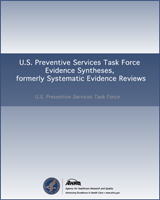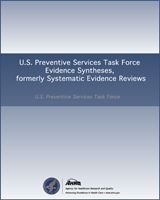NCBI Bookshelf. A service of the National Library of Medicine, National Institutes of Health.
Dehmer SP, Maciosek MV, Flottemesch TJ. Aspirin Use to Prevent Cardiovascular Disease and Colorectal Cancer: A Decision Analysis: Technical Report [Internet]. Rockville (MD): Agency for Healthcare Research and Quality (US); 2015 Sep. (Evidence Syntheses, No. 131s.)
This publication is provided for historical reference only and the information may be out of date.

Aspirin Use to Prevent Cardiovascular Disease and Colorectal Cancer: A Decision Analysis: Technical Report [Internet].
Show detailsAppendix A Table 1
Comparison of Baseline Modeled CVD Event Rates With National Prevalence Estimates.
Appendix A Table 2
Lifetime Discounted Net Benefit of Aspirin for Men and Women (KQ 1a).
Appendix A Table 3
Discounted Net Benefit of Aspirin Over 20 Years for Men and Women (KQ 1b).
Appendix A Table 4
Discounted Net Benefit of Aspirin Over 10 Years for Men and Women (KQ 1c).
Appendix A Table 5
Detailed Benefits and Harms From Aspirin Use for Men Aged 40-49 (KQs 1a-c).
Appendix A Table 6
Detailed Benefits and Harms From Aspirin Use for Women Aged 40-49 (KQs 1a-c).
Appendix A Table 7
Detailed Benefits and Harms From Aspirin Use for Men Aged 50-59 (KQs 1a-c).
Appendix A Table 8
Detailed Benefits and Harms From Aspirin Use for Women Aged 50-59 (KQs 1a-c).
Appendix A Table 9
Detailed Benefits and Harms From Aspirin Use for Men Aged 60-69 (KQs 1a-c).
Appendix A Table 10
Detailed Benefits and Harms From Aspirin Use for Women Aged 60-69 (KQs 1a-c).
Appendix A Table 11
Detailed Benefits and Harms From Aspirin Use for Men Aged 70-79 (KQs 1a-c).
Appendix A Table 12
Detailed Benefits and Harms From Aspirin Use for Women Aged 70-79 (KQs 1a-c).

Appendix A Figure 1
Comparisons in Lifetime Net Benefit From Taking Aspirin Averaged Across All Age, Sex, and Baseline CVD Risk Groups (KQs 1a-c, Deterministic Sensitivity). Notes: ASA=acetylsalicylic acid (aspirin); CRC=colorectal cancer; RR=relative risk; CVD=cardiovascular (more...)
Appendix A Table 13
Comparisons in Lifetime Net Benefit From Taking Aspirin for Men and Women at 10% CVD Risk (KQ 1a, Deterministic Sensitivity).
Appendix A Table 14
Comparisons in Net Benefit From Taking Aspirin Over 20 Years for Men and Women at 10% CVD Risk (KQ 1b, Deterministic Sensitivity).
Appendix A Table 15
Comparisons in Net Benefit From Taking Aspirin Over 10 Years for Men and Women at 10% CVD Risk (KQ 1c, Deterministic Sensitivity).
Appendix A Table 16
Marginal Discounted Lifetime Net Benefit From Taking Aspirin Now Versus Delaying 10 Years (KQ 2).
Appendix A Table 17
Comparison of Modeled Baseline (Preventable) 10-Year Event Rates to 2009 USPSTF Review.
Appendix A Table 18
Comparison of Modeled Baseline GI Bleeding and Hemorrhagic Stroke Event Rates.

Appendix A Figure 2
Comparison of 10-Year Model Outcomes With ACC/AHA 10-Year Risk Among Men Aged 40-79 Years. Notes: ACC/AHA=American College of Cardiology/American Heart Association. The y-axis represents the percent of persons observed having their first hard atherosclerotic (more...)

Appendix A Figure 3
Comparison of 10-Year Model Outcomes With ACC/AHA 10-Year Risk Among Women Aged 40-79 Years. Notes: ACC/AHA=American College of Cardiology/American Heart Association. The y-axis represents the percent of persons observed having their first hard atherosclerotic (more...)
Appendix A Table 19
Comparison of Positive Net Event Thresholds by CVD Risk Over a 10-Year Horizon to 2009 USPSTF Review.
Appendix A Table 20
Comparison of Major Event Rates to van Kruijsdijk et al (2015).
Appendix A Table 21
Comparison of Major Event Rates to Cuzick et al (2015).
Appendix A Table 22
Comparison of CVD and CRC Mortality Rates in Model Results Versus Clinical Trials.
References
- 1.
- Aspirin for the prevention of cardiovascular disease: U.S. Preventive Services Task Force recommendation statement. Ann Intern Med. 2009;150(6):396–404. [PubMed: 19293072]
- 2.
- Goff DC Jr., et al. 2013 ACC/AHA guideline on the assessment of cardiovascular risk: a report of the American College of Cardiology/American Heart Association Task Force on Practice Guidelines. J Am Coll Cardiol. 2014;63(25 Pt B):2935–59. [PMC free article: PMC4700825] [PubMed: 24239921]
- 3.
- Hernandez-Diaz S, Garcia Rodriguez LA. Cardioprotective aspirin users and their excess risk of upper gastrointestinal complications. BMC Med. 2006;4:22. [PMC free article: PMC1590044] [PubMed: 16987411]
- 4.
- Wolff T, Miller T, Ko S. Aspirin for the primary prevention of cardiovascular events: an update of the evidence for the U.S. Preventive Services Task Force. Ann Intern Med. 2009;150(6):405–10. [PubMed: 19293073]
- 5.
- De Berardis G, et al. Association of aspirin use with major bleeding in patients with and without diabetes. JAMA. 2012;307(21):2286–94. [PubMed: 22706834]
- 6.
- Incidence and Prevalence: 2006 Chart Book on Cardiovascular and Lung Diseases. Bethesda, MD: National Heart, Lung, and Blood Institute; 2006.
- 7.
- Mozaffarian D, et al. Heart disease and stroke statistics-2015 update: a report from the american heart association. Circulation. 2015;131(4):e29–e322. [PubMed: 25520374]
- 8.
- Kleindorfer DO, et al. Stroke incidence is decreasing in whites but not in blacks: a population-based estimate of temporal trends in stroke incidence from the Greater Cincinnati/Northern Kentucky Stroke Study. Stroke. 2010;41(7):1326–31. [PMC free article: PMC2904073] [PubMed: 20489177]
- 9.
- Ridker PM, Cook NR. Statins: new American guidelines for prevention of cardiovascular disease. Lancet. 2013;382(9907):1762–5. [PubMed: 24268611]
- 10.
- Kavousi M, et al. Comparison of application of the ACC/AHA guidelines, Adult Treatment Panel III guidelines, and European Society of Cardiology guidelines for cardiovascular disease prevention in a European cohort. JAMA. 2014;311(14):1416–23. [PubMed: 24681960]
- 11.
- Muntner P, et al. Validation of the atherosclerotic cardiovascular disease Pooled Cohort risk equations. JAMA. 2014;311(14):1406–15. [PMC free article: PMC4189930] [PubMed: 24682252]
- 12.
- DeFilippis AP, et al. An analysis of calibration and discrimination among multiple cardiovascular risk scores in a modern multiethnic cohort. Ann Intern Med. 2015;162(4):266–75. [PMC free article: PMC4414494] [PubMed: 25686167]
- 13.
- van Kruijsdijk RC, et al. Individualised prediction of alternate-day aspirin treatment effects on the combined risk of cancer, cardiovascular disease and gastrointestinal bleeding in healthy women. Heart. 2015;101(5):369–76. [PMC free article: PMC4536552] [PubMed: 25475110]
- 14.
- Cuzick J, et al. Estimates of benefits and harms of prophylactic use of aspirin in the general population. Ann Oncol. 2015;26(1):47–57. [PMC free article: PMC4269341] [PubMed: 25096604]
- 15.
- Guirguis-Blake JM, et al. Aspirin for the Primary Prevention of Cardiovascular Events: A Systematic Evidence Review for the U.S. Preventive Services Task Force. Agency for Healthcare Research and Quality; Rockville, MD: 2015. (Prepared by Kaiser Permanente Research Affiliates Evidence-based Practice Center under Contract No HHSA-290-2012-00015-EPC4, Task Order 2) [PubMed: 26491760]
- 16.
- Chubak J, et al. Aspirin Use for the Prevention of Colorectal Cancer: An Updated Systematic Evidence Review for the US Preventive Services Task Force. Agency for Healthcare Research and Quality; Rockville, MD: 2015. (Prepared by the Kaiser Permanente Research Affiliated Evidence-based Practice Center under Contract No. HHSA-2900-2012-00015-I, Task Order No. 2) [PubMed: 26491758]
- Appendix A - Aspirin Use to Prevent Cardiovascular Disease and Colorectal CancerAppendix A - Aspirin Use to Prevent Cardiovascular Disease and Colorectal Cancer
Your browsing activity is empty.
Activity recording is turned off.
See more...
